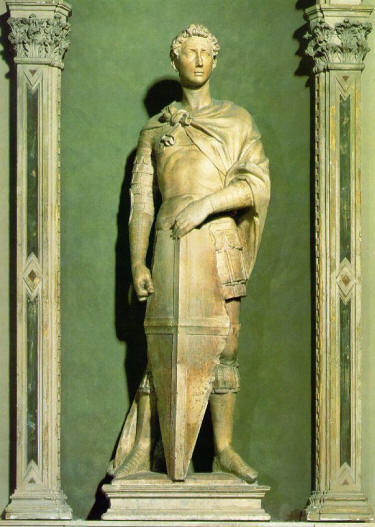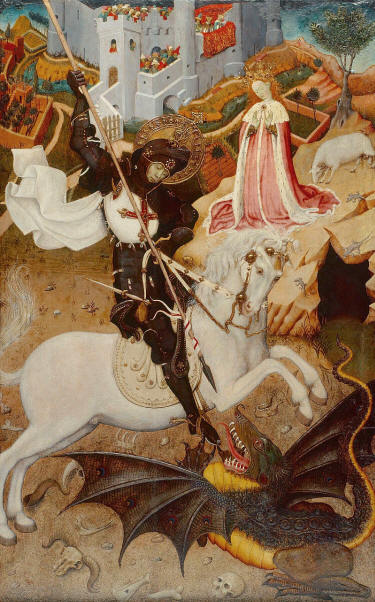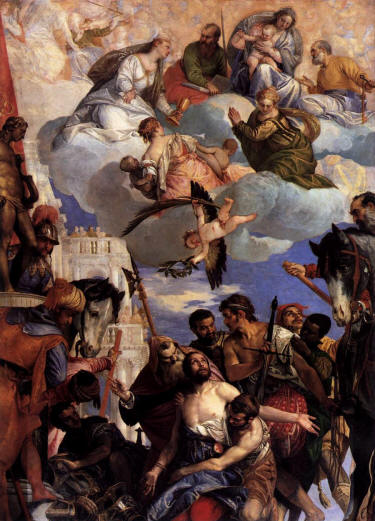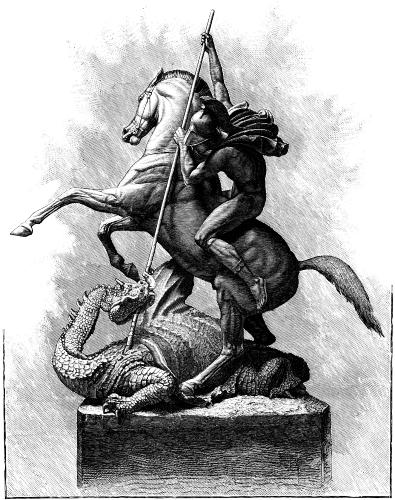| |
|
|
| |
|
|
| |
 |
| |
|
There is almost nothing
known of the early years of Saint George's life. He was born sometime in
the year 263AD, in the city of Lydia near Jerusalem. His parents were from
Cappadonia, a city in present day Turkey. Is is said that his father was
an Arab Sheit.
Sometime in his seventeenth year, he enlisted as a calvary soldier in the
army of the Roman Emperor Diocletian. He became a high ranking officer,
rising through the ranks because he was a proficient soldier, an able
horseman and had a commanding and cheerful attitude.
When the Emperor Diocletian began his
campaign of persecuting Christians, George,
who was a devout Christian, |
 |
|
Click on image above to view full
size |
|
|
|
|
requested an audience
with the Emperor and was granted
one. George at this conference
pleaded with the Emperor to refrain from
this distasteful practice. Diocletian was so
annoyed and incensed, that he commanded
George to recant his religion. When he
refused, George was arrested, tortured, and |
|
|
|
 |
finally
put to death on April 23, 303 AD. This day is now known as Saint George's
Day. Ancient
storytellers told legends of an
Eastern city called Salem where a
terrifying
dragon lived in a swamp nearby. The dragon demanded a daily
tribute of sheep and cattle. Soon, after exhausting these food supplies,
the dragon demanded the sacrifice of two children a day. A lottery system
was devised to pick the victims. Cleodolinda, the daughter of the King, was chosen for that day's sacrifice.
As Cleodolinda was sadly proceeding
to her doom, along came the knight George.
Seeing the dragon about to gulp down the
lovely princess, George promised the
citizens deliverance from their troubles.
After making the sign of the cross, he
transfixed the dragon |
|
Click on image above to view full
size |
|
|
|
|
with his lance and wounded it
with his magic sword Ascalon. George then had the princess bind the beast
with her girdle. The dragon then became docile and tame, and followed the
princess and George back to the city. There in the market square, George
killed the dragon with his lance. |
|
|
|
As George was killing the dragon, he told the city citizens that this act
was to show the power of God. Not only was the princess saved and the city
relieved, but the people gave up their idols and accepted Christianity.
George was said to have married the princess and lived happily ever after.
George was canonized by Pope Gelasius in 494AD. The Pope said St. George
was one of those "...whose names are justly reverenced among men, but
whose acts are known only to God." St. George exemplified courage,
devotion, piety, leadership, truthfulness and dedication. Crusaders
venerated him and wore his cross (red on a white background). |
 |
|
Click on image above to view full
size |
|
|
|
|
King Edward III of England chose George to
be the patron Saint for the Knight of the
Garter. During this time he also became the
patron Saint of Portugal and Italy. Czarina
Catherine II founded the Russian Order of
Saint George. |
|
|
|
 |
If you think of this tale as an allegory rather than a legend; with Saint
George representing Christianity and the dragon as paganism, this shows us
how good triumphs over evil. Baden-Powell often used this as a symbol in
the character building program of Scouting. The Rover program started in
1917 is based on a Knighthood theme, with the symbol of St. George, patron
saint of Scouts, being important. St. George is typical of what a Scout
should be. He epitomized the qualities of selflessness and both moral and
physical courage which Baden-Powell saw as being among the aims of
Scouting. |
|
|
| |
|